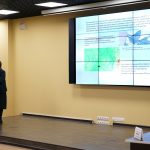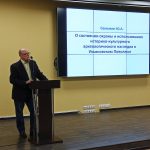All-Russian archaeological conference “Problems of studying, preservation and museumification of archaeological sites in the urban space”
On November 24-25, 2022, in the conference hall of the historical park “Russia – my history”, a branch of the Samara Regional Museum of Local History named after P.V. Alabin, the All-Russian archaeological conference “Problems of studying, preservation and museumification of archaeological sites in urban space”, devoted to the 100th anniversary of the opening of “Postnikov ravine” complex in Samara was held. The event was organized by the Samara Regional Museum of Local History named after P.V. Alabin together with the Institute of Archaeology named after A.H. Khalikov of the Tatarstan Academy of Sciences, LLC “Institute of Archaeology of the Volga region”, Samara State University of Social Sciences and Education. The conference was held in the face-to-face and online formats.
The “Postnikov ravine” site assemblage has been studied by archaeologists since the beginning of the last century; in 1995 it was given the status of the archaeological site of the federal significance. 12 objects were found here in the XX century; in the XXI century-7. Traces of human activity from the end of the Upper Paleolithic (15-20 thousand years ago) are represented on the territory of the monument. From the excavations, that were carried out in 1922-1927 by V.V. Golmsten, come artefacts of the Paleolithic, Mesolithic, Neolithic-Eneolithic, Bronze Age, Early Middle Ages, and the last inhabitants at the mouth of the ravine were Mordovian and Russian population in the Golden Horde period. Besides that, the burial of a medieval nomad was found in the vicinity of the ravine. Unfortunately, as a result of modern dense urban development the site “Postnikov ravine” is practically not available for scientific studies.
The scientists from Samara, Kazan, Lipetsk, Voronezh, Ulyanovsk, Syzran and Saransk took part in the conference. There were presented 25 reports, devoted to the study of different archaeological monuments in Samara Oblast and other regions from the Stone Age to the Modern era. The director of the Samara Regional Museum of Local History named after P.V. Alabin A.V. Kochetkov welcomed the participants and guests of the conference.
The main stages of studying of the “Postnikov ravine” site assemblage and the evolution of the stone industry of the population of the ancient station-workshop Postnikov ravine-III were represented in the report of L.V. Kuznetsova, candidate of historical sciences, senior research fellow of the department of archaeology of the Samara Regional Museum of Local History named after P.V. Alabin; M.Sh. Galimova, candidate of historical sciences, head of the primeval archaeology department of the Institute of Archaeology named after A.H. Khalikov of the Tatarstan Academy of Sciences made the report “Postnikov ravine in the light of A.H. Khalikov’s concept and discussion on genesis of the Upper Paleolithic stone industries of the Volga river region and the Urals”.
An extensive block of reports by doctor of historical sciences A.A. Vybornov, candidate of historical sciences A.I. Korolyov, candidate of historical sciences A.N. Bessudnov (Lipetsk), doctor of historical sciences Ye.Yu. Zakharova (Voronezh), candidate of historical sciences K.M. Andreyev, post-graduate students and research fellows of the Samara State University of Social Sciences and Education was devoted to the stone industry and burial rites of the Stone Age and Chalcolithic sites on the territory of the Samara Oblast, the Republic of Tatarstan, the Republic of Mari El, Don river and Caspian sea regions; the second representative block of reports was devoted to the medieval archaeology of Volga river region: reports by a doctor of historical sciences K.A. Rudenko (Kazan), M.R. Gismatulin (Ulyanovsk), D.A. Kozlov (Saransk), N.I. Glazistova (Samara).
The speakers paid special attention to the prospects of archaeological heritage preservation and issues of museumification of archaeological sites in the urban space. This problem was presented in the papers of candidate of historical sciences, scientific secretary of the Samara Regional Museum of Local History named after P.V. Alabin D.A. Stashenkov; candidate of historical sciences Yu.A. Semykin (Ulyanovsk); head of the department of archaeology of the Samara Regional Museum of Local History named after P.V. Alabin A.F. Kochkina.







